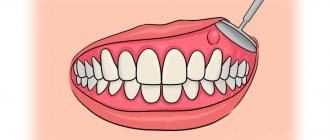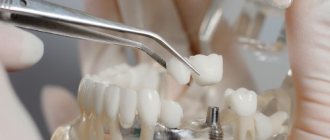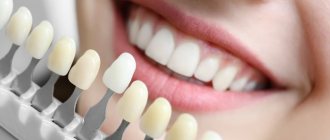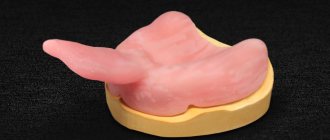From this article you will learn:
- what antibiotics are used for inflammation of the gums, tooth roots, gumboil,
- choice of antibiotic and dosage regimen,
- is it possible to give injections in the gums,
- causes of diarrhea after taking antibiotics.
The article was written by a dental surgeon with more than 19 years of experience.
Antibiotics are medicines that have antimicrobial properties and inhibit the growth and reproduction of pathogenic microorganisms. In dentistry, antibiotics are most often prescribed either for inflammation of the gums or for apical periodontitis (i.e., in the treatment of purulent inflammation at the apex of the tooth root). In each of these cases, inflammation is caused by different types of pathogenic bacteria and/or microbial associations, which requires the correct choice of drug before starting antibacterial therapy in the oral cavity.
In most cases, antibiotics in dentistry are prescribed “empirically”, i.e. without preliminary microbiological examination. Therefore, the dentist must be familiar with the likely composition of the microflora in the source of inflammation in various dental diseases (periodontitis, periodontitis, gumboil on the face), and also be aware of current data on the resistance of pathogenic bacteria to various types of antibiotics. Therefore, part 1 of our article will be devoted to what antibiotics are needed for gum gum disease and the development of purulent inflammation at the root of the tooth, and the second part will be devoted to how to choose the optimal antibiotic for gum inflammation (i.e., chronic generalized periodontitis).
Important: the treatment regimens described below are for informational purposes only, because An attempt to relieve inflammation without going to the dentist always leads to only a temporary improvement, but a more aggressive course of inflammation in the future. Therefore, we recommend taking antibiotics only as prescribed by a doctor!
What is tooth flux?
Flux, or, in dentist's language, periostitis, is a very unpleasant pathology, which is characterized by inflammation of the periosteum and soft tissues. The causes of flux on the gums can be different: trauma, gum disease, poor-quality dental treatment - all this can lead to a complication in the form of periostitis. The localization of the disease does not depend on the area of the jaw: flux of the upper and lower teeth occurs equally often.
Flux under a tooth (or above a tooth, if we are talking about the upper jaw) visually resembles an inflamed sac. However, this is far from the only possible manifestation of periostitis. There is also a serous form, when the periosteum becomes inflamed as a result of trauma and damage, as well as one of the most unpleasant types - diffuse, when the infection is localized in different parts of the jaw, which requires extensive surgical intervention with the participation of a maxillofacial surgeon.
What undesirable effects are possible during the course of medication?
Side effects depend on the active compound of the particular drug and the individual characteristics of the patient’s body. Common complications caused by long-term antibiotic therapy include :
- Disturbances in the gastrointestinal tract, dysbacteriosis. The conditions are manifested by nausea, loss of appetite, diarrhea, abdominal pain, and flatulence.
- Decreased performance, muscle weakness.
- Dizziness.
- Allergic reactions. Usually these are skin rashes and itching. Swelling also often develops.
If the antibiotic is poorly tolerated, a repeated consultation with the dentist is indicated. It is possible that the doctor will replace the medication with a safer analogue.
Symptoms of gumboil
Flux on the gums in adults occurs much more often than in children (approximately 80-90 percent of all cases). A characteristic feature of the pathology is that it does not go unnoticed. This is one of the most unpleasant diseases, causing severe discomfort. The most striking symptoms are the classic purulent flux.
Symptoms
- Severe throbbing pain.
- Inflammation and swelling of soft tissues. At the advanced stage, the side of the face on which the flux is diagnosed swells.
- Enlarged lymph nodes.
- Discomfort and pain when eating and talking.
- Flux of the lower tooth (in the molar area) can lead to numbness of the lip and part of the chin.
- Weakness, headache, fever.
Swelling on the inside of the cheek
Anesthesia makes tooth extraction easier. But, if after treatment of a tooth your cheek is swollen, you should find out the origin of the pathology. You may need treatment for your gums. Discomfort appears in many patients after depulpation. Pain and swelling on the inside of the cheek can be observed from 2 hours to 7 days. If discomfort intensifies or occurs 2 days after surgery, you should immediately consult a dentist.
If, after removing the nerve, in addition to painful sensations, the gums become inflamed, purulent discharge appears, and the temperature rises, you should visit a dentist. He will find out why the cheek is swollen and how to remove the gumboil.
Attention! You cannot take painkillers and anti-inflammatory drugs before consulting a doctor; this will complicate the diagnosis, which will not allow you to prescribe adequate treatment.
How many days does tooth flux last?
Waiting for the flux to disappear on its own is, to say the least, naive. Some patients believe that if the flux bursts and pus comes out of the wound, then further treatment may not be carried out at all. This is a big mistake, since complete removal of pus requires special drainage, as well as complex therapy and subsequent treatment in the dentist’s chair. With timely and correct treatment, the flux disappears on average in 12-14 days; rehabilitation after severe periostitis can take more than a month.
Propolis tincture
Propolis tincture has a strong anti-inflammatory effect and wound healing effect. Tannins relieve pain well. And essential oils and flavonoids are powerful natural antibiotics. To treat gumboil, 15 ml of propolis tincture is diluted in half a glass of warm boiled water. The solution is used for rinsing. You can moisten a cotton pad with undiluted tincture and apply it to the inflamed area overnight.
Treating flux with propolis in its natural form is also effective. It must be chewed throughout the day until the toothache disappears.
Propolis tincture can be purchased at a pharmacy or prepared at home yourself. To do this, 20 g of propolis is finely crushed and filled with 100 ml of 70% medical ethyl alcohol. Infused in a dark glass bottle for 14 days.
Treatment methods
The attending physician should tell you after the examination how to treat gumboil and what measures need to be taken to achieve a successful result. The mechanism is approximately the same, but each clinical case has its own nuances. Today, several techniques are used aimed at eliminating the disease and its manifestations. As a rule, they come together.
Antibiotics for gumboils
Antibiotic treatment is an important stage of rehabilitation. The most effective antibiotics for fighting inflammation and infection are Metronidazole, Lincomycin, Amoxiclav and their analogues. Any tablets and antibiotics for tooth flux should be taken only as prescribed by a doctor!
Physiotherapy
Used as an additional measure to reduce inflammation and speed up recovery. Recommended procedures include electrophoresis, laser and ultrasound therapy.
Therapeutic treatment
It is carried out if it is decided to save the tooth. This includes endodontic treatment and filling of root canals, as well as resection of the root apex if necessary. If the cause of the flux is periodontitis, then a series of manipulations are carried out to eliminate the accumulation of bacteria in the periodontal pockets.
Surgical procedures
This includes tooth extraction and periostotomy - the main procedure for treating flux. The doctor makes an incision into the purulent sac, and then installs a drain through which the purulent exudate comes out.
Local therapy and rinsing for tooth flux
For better release of pus, pain relief and reduction of swelling, gels and ointments are used topically: Metrogyl Denta, Levomekol, Cholisal. Many people are interested in how to rinse gumboil on the gums. Miramistin and soda solution are usually used for rinsing. As an alternative, you can use folk remedies: decoctions and tinctures of propolis, chamomile, sage or calendula. A tooth after gumboil is still very vulnerable: to minimize the risk of re-infection, these treatment and preventive procedures are very important.
Forms of release of antibacterial agents used in dentistry
Dentists use drugs in the form of:
- Ointments and gels. Designed for local treatment of affected gums. Qualitatively relieve inflammation and reduce pain symptoms. As a rule, ointment and gel formulations are applied two to four times a day. It is important to use the medication regularly and strictly according to the regimen selected by a specialist. Only then will it be possible to achieve positive dynamics.
- Tablets and capsules. The most popular types of antimicrobial agents intended for oral administration. The daily dosage is determined by the doctor. When deciding which antibiotics to prescribe, the doctor must take into account the patient’s health condition. It is unacceptable to include in therapy drugs that can aggravate the course of existing diseases of internal organs.
- Solutions for injection. Injections are given intravenously or intramuscularly. This is the most effective option for antibacterial therapy. It is used for complicated and advanced forms of dental disease.
Is a tooth removed during gumboil?
A tooth can be removed due to flux, but in modern dentistry the emphasis is on tooth-preserving manipulations. This also applies to flux. A tooth must be removed when its crown is seriously damaged and cannot be restored with a pin or inlays. If an infection occurs under the crown, then re-prosthetics are often difficult. In some cases, a tooth has to be removed because it is impossible to unfill the canals after a previous unsuccessful treatment, but this happens extremely rarely. In any case, the doctor makes the decision to remove a tooth based on the clinical picture.
Anti-inflammatory drugs
You can quickly relieve swelling and reduce pain at home with flux using anti-inflammatory non-steroidal drugs. They are available in the form of tablets, suspensions, and powders.
"Nimesil"
The main anti-inflammatory “dental” remedy. The main component is nimesulide. It has a strong anti-edematous, anti-inflammatory effect, and to a lesser extent – antipyretic and analgesic. These properties make Nimesil the No. 1 drug in the treatment of periostitis.
The main component is nimesulide.
The medicine is prescribed for adults and children over 12 years of age, 1 sachet twice a day. It is not recommended for patients with disorders of the intestines, liver, heart or during pregnancy.
The price of one sachet of “Nimesil” is 20–30 rubles.
Why is tooth flux dangerous?
An inflammatory process of this type tends to develop and, as it spreads, affects deeper layers of tissue. If left untreated, flux often develops into phlegmon - a serious purulent inflammation that has no definite boundaries. The most severe forms of flux provoke the development of sepsis, which can lead to infection of the entire body and even death. It is important not only to know how to cure gumboil and visit the dentist on time, but also to follow a number of preventive measures so that the likelihood of complications developing is minimal.
- Regular and high-quality hygiene.
- Treatment of caries at the initial stage. Flux, dental cysts and other complications often arise due to untreated pulpitis and periodontitis.
- Preventative visits to the clinic to assess the condition of the oral cavity and carry out professional cleaning.
Folk recipes
Herbs and plant extracts have a beneficial effect on oral tissues. They can be used to relieve inflammation. When dealing with flux, you should arm yourself with:
- Oak bark. An infusion is prepared from it: pour two spoons into 200 ml of boiling water and wait for one hour. After filtering, the composition is ready for use. All products based on oak bark stain teeth. This is their significant drawback.
- Sage. You should mix a teaspoon of aromatic dry raw materials with a glass of hot boiling water. After half an hour, filter. During the procedure, the medicine should be slightly warm.
- Chamomile. Very popular for various dental diagnoses. Excellently suppresses inflammatory processes. Antiseptic. It can be combined with string and yarrow. The preparation recipe is standard: a tablespoon of vegetable mixture per glass of boiling water.
- Propolis. Suitable for making tinctures with alcohol. It must be infused strictly at room temperature. Dilute a teaspoon in a cup of water and rinse the flux in the morning, afternoon and evening.











